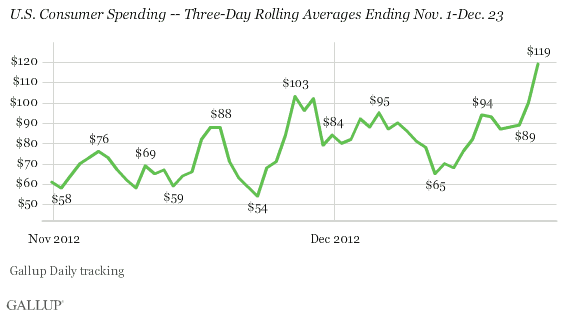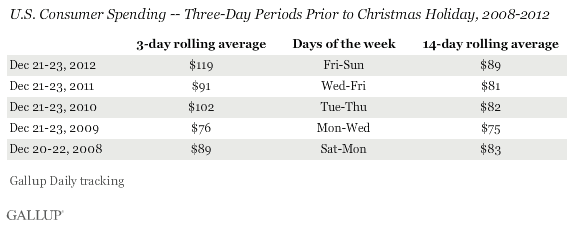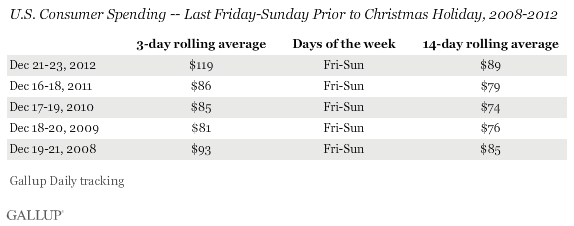WASHINGTON, D.C. -- Americans' self-reported daily spending surged to $119 during the pre-Christmas weekend spanning Dec. 21-23, easily the highest three-day average for the holiday season and for the year. This is also the best pre-Christmas showing since Gallup began daily tracking of consumer spending in 2008.

The eleventh-hour surge may help boost retail sales figures that had been largely viewed as disappointing to date this holiday season. Indeed, the $119 daily average for the 2012 pre-Christmas weekend was easily the highest of December; the previous high was $100 for the days spanning Dec. 19-22. Prior to that, the previous highs for both the holiday season and the year were $103 for Nov. 25-27 and $102 for Nov. 27-29 -- the days following Thanksgiving, during which Black Friday and Cyber Monday sales lured bargain-hungry shoppers.
More broadly, the surge in Americans' spending during the pre-Christmas weekend marks a return to spending levels not seen since 2008, when Americans regularly reported daily spending well into the triple digits.
Pre-Christmas Weekend Beats Comparables Since 2008
This year's daily average for the three-day period before Christmas Eve and Christmas Day easily tops that of previous years since Gallup began tracking consumer spending in 2008. One reason may be that this period fell on a Friday through Sunday this year, whereas it often fell during weekdays in previous years. Even so, the 14-day rolling average ending with this period still tops that of previous years.

This year's average also tops previous Friday-Sunday periods leading up to the Christmas holiday.

Bottom Line
Gallup Daily tracking suggests that Americans spent more in the three days leading up to Christmas Eve and Christmas Day this year than they have at any time since the financial crisis began in late 2008. While the timing of this period may have been a factor, this is true whether comparing this Dec. 21-23 to the immediate three-day periods leading up to Christmas or comparing Friday-Sunday periods from previous years. This is also true despite the fact that Thanksgiving fell a week earlier than usual this year, extending the length of the holiday season.
The last-minute surge may be good news for retailers and the economy as businesses prepare to finalize their revenue figures for 2012. Americans may in fact have fulfilled their intention to spend slightly more this holiday season than last year. Still, Americans are taking a wait-and-see approach to assessing the economy more broadly, and they are increasingly pessimistic that political leaders will reach a deal to avoid the "fiscal cliff" by Jan. 1. As such, there is a very real possibility that post-holiday daily spending will return to the general levels seen throughout much of 2011 and 2012.
Survey Methods
Results are based on telephone interviews conducted as part of the Gallup Daily tracking survey Dec. 21-23, 2012, with a random sample of 1,440 adults, aged 18 and older, living in all 50 U.S. states and the District of Columbia.
For results based on the total sample of [national adults/registered voters], one can say with 95% confidence that the maximum margin of sampling error is ±3 percentage points.
Interviews are conducted with respondents on landline telephones and cellular phones, with interviews conducted in Spanish for respondents who are primarily Spanish-speaking. Each sample includes a minimum quota of 400 cellphone respondents and 600 landline respondents per 1,000 national adults, with additional minimum quotas among landline respondents by region. Landline telephone numbers are chosen at random among listed telephone numbers. Cellphone numbers are selected using random-digit-dial methods. Landline respondents are chosen at random within each household on the basis of which member had the most recent birthday.
Samples are weighted by gender, age, race, Hispanic ethnicity, education, region, adults in the household, and phone status (cellphone only/landline only/both, cellphone mostly, and having an unlisted landline number). Demographic weighting targets are based on the March 2011 Current Population Survey figures for the aged 18 and older non-institutionalized population living in U.S. telephone households. All reported margins of sampling error include the computed design effects for weighting and sample design.
In addition to sampling error, question wording and practical difficulties in conducting surveys can introduce error or bias into the findings of public opinion polls.
For more details on Gallup's polling methodology, visit https://www.gallup.com/.
